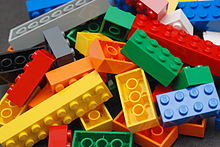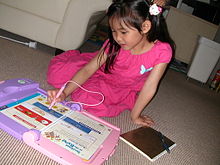This article needs additional citations for verification. (January 2017) |


Educational toys (sometimes also called "instructive toys")[1] are objects of play, generally designed for children, which are expected to stimulate learning. They are often intended to meet an educational purpose such as helping a child develop a particular skill or teaching a child about a particular subject. They often simplify, miniaturize, or even model activities and objects used by adults.
Although children are constantly interacting with and learning about the world, many of the objects they interact with and learn from are not toys. Toys are generally considered to be specifically built for children's use. A child might play with and learn from a rock or a stick, but it would not be considered an educational toy because 1) it is a natural object, not a designed one, and 2) it has no expected educational purpose.
The difference lies in perception or reality of the toy's intention and value. An educational toy is expected to educate. It is expected to instruct, promote intellectuality, emotional or physical development. An educational toy should teach a child about a particular subject or help a child develop a particular skill. More toys are designed with the child's education and development in mind today than ever before.